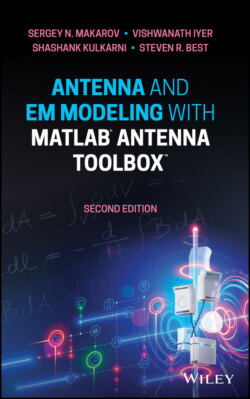Читать книгу Antenna and EM Modeling with MATLAB Antenna Toolbox - Sergey N. Makarov - Страница 28
Example 1.6
ОглавлениеUsing MATLAB Antenna Toolbox, compare theory and numerical simulations for the strip dipole antenna with lA = 15 cm, t = 8 mm over the band 200–1200 MHz. The theory model uses Eq. (1.14).
Solution: A simple MATLAB script given below initializes the dipole antenna, plots the antenna geometry, and computes the dipole input impedance over the frequency band of interest at the default computational mesh resolution. Figure 1.6 shows the resulting dipole geometry and the impedance comparison. The agreement between two solutions is good in the middle of the band, but it becomes worse at higher frequencies and at very low frequencies. There, the numerical solution generally becomes more accurate.
Figure 1.6 Dipole antenna impedance in the vicinity of its first (series) resonance. The dashed line shows the resonant frequency. The solid curves show the analytical antenna impedance. The dash‐dot curves show the simulated antenna impedance.
%% Setup analysis parameters f = linspace(200e6, 1200e6, 1000); % Frequency in Hz lA = 0.15; % Dipole total length, m a = 0.002; % Dipole radius, m %% Antenna toolbox model and analysis w = cylinder2strip(a); % Eq. strip width model d = dipole('Length',lA,'Width',w); % Strip dipole model figure; show(d) % Visualize geometry Z = impedance(d, f); % Full-wave MoM solution R = real(Z); % Resistance X = imag(Z); % Reactance
Emphasize that the numerical solution uses an infinitesimally thin feed gap for the dipole antenna. An extension to a gap of finite thickness is possible.
We have already mentioned that, if a strip or blade dipole of width t is considered, then a twice as narrow cylindrical dipole provides the same equivalent capacitance of a dipole wing per unit length [3]. For example, the blade dipole of 8 mm in width and the cylindrical dipole of 4 mm in diameter should perform quite similarly.
The results from our numerical experiment suggest that the existing theory model is a good approximation for dipoles around the first resonance. Eq. (1.14) indeed quickly loses its validity above the first antenna resonance. The numerical model is also not perfect, but it is perhaps more reliable. We emphasize that the dipole theory model is still extremely useful in the estimation of the antenna path loss where its accuracy is quite sufficient; this question will be considered in the following text.
